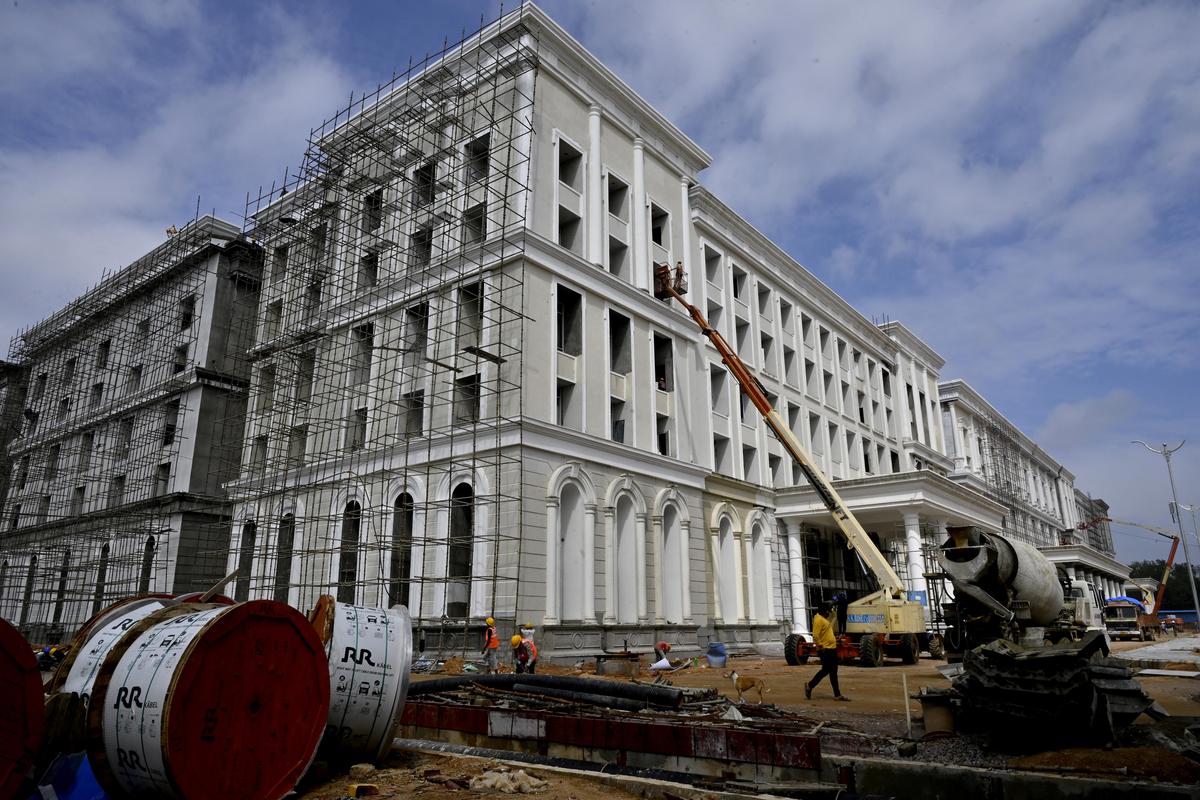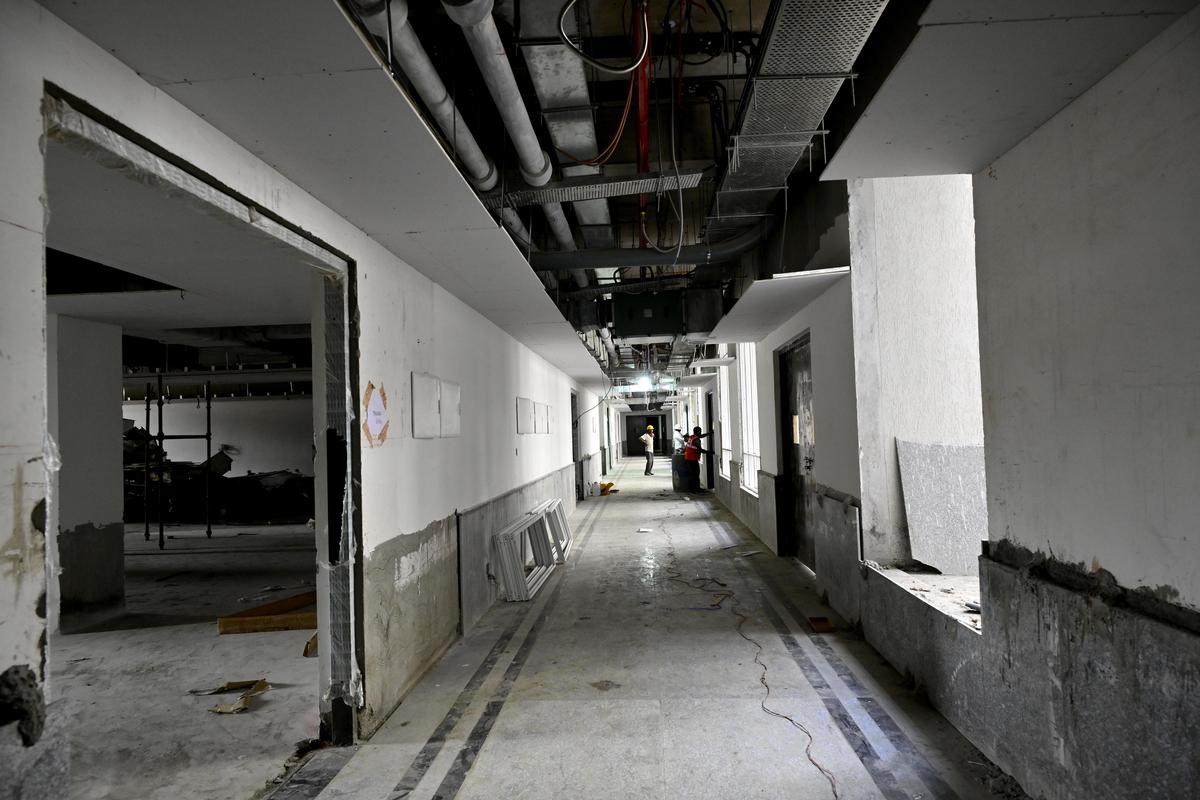Five years ago, when the COVID-19 pandemic brought the world to its knees, cities everywhere were forced to confront the fragility of their public health systems. Hyderabad was no exception; it had just one government facility equipped to handle the crisis — Gandhi Hospital. Its wards overflowed with patients and the medical staff worked around the clock, battling exhaustion and fear in equal measure. Those desperate times sparked a long-overdue realisation: that the State needed more resilient, better-equipped public hospitals that could stand firm in the face of any future public health emergency. Out of that urgency was born the Telangana Institute of Medical Sciences (TIMS) — a new generation of government hospitals that could match private facilities in both scale and sophistication.
Today, that idea conceived during the global emergency is taking solid shape at Sanathnagar, an industrial and residential neighbourhood of Hyderabad. A 1,000-bed super-speciality TIMS hospital is entering the final stretch of construction with officials said to have marked December 9 as the possible inauguration date.
The ₹1,070-crore project had received administrative sanction on April 21, 2022, followed by a foundation stone ceremony five days later.
A senior official of the Health Department says it will house 37 departments and function as a centre of excellence for cardiothoracic, cardiac and transplant sciences. Modeled on the lines of Nizam’s Institute of Medical Sciences, TIMS will operate under an autonomous system where medical and non-medical services would be managed separately. Of the total capacity, around 200 beds will be designated for paying patients.
Spread across 22.6 acres within the existing Government Chest Hospital campus and a total built-up area of 11.68 lakh square feet, the project is being executed by Megha Engineering and Infrastructures Ltd. (MEIL) under a design-build model, with M/s OCI Architects handling project management.
On a weekday afternoon, the construction site in Sanathnagar hums with unrelenting activity. Cranes swing overhead, cement mixers churn rhythmically and workers in white helmets move briskly between the newly built towers. A muddy road leads to the complex, flanked by parked trucks, their tyres caked in red soil. This rough stretch, still echoing with the sounds of drilling machines and hammers, will soon become the hospital’s parking area.
At the far end of the road stands a freshly built grey block — a G+5 ‘dharamshala’. Designed to accommodate 200 people, mostly patient attendants, it is nearly ready for handover, with only furniture yet to be fitted. For now, it doubles as a meeting space for Telangana government officials reviewing the project’s progress.
Adjacent to this, rise three identical G+5 towers — Blocks A, B and C, the heart of the medical complex. Near Block A, Ramesh, an electrician, pauses to wipe his face with a handkerchief. “I have been working at the site for six months now. Our contractor handles this section. We get paid monthly. I come from Yousufguda every day,” he says, echoing the pride of thousands of workers who have powered the project from blueprint to reality.
The walk across the vast premises feels almost endless, each turn revealing another stretch of concrete shimmering in the afternoon heat. By the time one reaches Block A, the scale of the project truly sinks in. Inside, the rooms echo with the thrum of finishing work, but a few, particularly the operation theatres, already gleam with readiness. Stainless steel fixtures line the walls and large LED screens hang beside the operating tables. In that sterile scent of fresh paint and polished metal, the promise of TIMS becomes tangible — a government hospital that looks and feels like a corporate facility.
Standing amid the dust and din, MEIL president (Projects) Govardhan Reddy is clear about the timeline. “We have been told that December 9 will be the inauguration day. Before that, everything, right from furniture to equipment, will be installed and ready. The doctors’ team is already inspecting the rooms to verify where each piece of equipment will go,” he says.
According to him, 99% of the civil work has been completed, with only finishing, electrical fittings, and mechanical, electrical and plumbing work pending. “Civil work forms about 70% of the total project, and that is practically done. Now we are focusing on installing MRI, CT scanners and X-ray units, most of which are either on-site or in transit,” he says.
The journey, he admits, hasn’t been without challenges. “At first, we had to clear a large plantation area and coordinate with the Forest Department to relocate trees. That was one of the biggest hurdles. But it is all settled now,” he says with a hint of relief.
Sustainability and scale
Sustainability, too, is woven into the design. “We are installing solar panels on the terrace, and those will be up soon. Even the hospital’s hot water system will be solar-powered,” says Reddy, adding that the setup is designed to cut long-term energy costs.
Planned as a multi-block facility, TIMS Sanathnagar brings together every essential function of a super-specialty hospital within its campus. Block A will house emergency services, 15 operation theatres and 30 ICUs. Block B will serve as the main OP registration area, complete with a centralised pharmacy, cardiac operation theatre, and a LINAC-based nuclear medicine ward to support oncology and cardiac services, apart from cath labs.
Block C will accommodate radiology and pathological labs, general and private wards, and even VIP suites while Block D is earmarked for administrative and academic purposes, featuring an auditorium that can seat 200 people.

In all, the hospital will have 16 major and six minor operation theatres, alongside a diagnostics wing equipped with 17 pathology labs, 12 microbiology labs, 10 biochemistry labs and five specialised laboratories.
| Photo Credit:
NAGARA GOPAL
In all, the hospital will have 16 major and six minor operation theatres, alongside a diagnostics wing equipped with 17 pathology labs, 12 microbiology labs, 10 biochemistry labs and five specialised laboratories — a scale of infrastructure rarely seen in government healthcare.
The institute will be equipped with advanced imaging technology, including a 3.0 Tesla MRI machine, a 128-slice CT scanner, a mammography unit and five X-ray machines.
To ensure comprehensive patient and attendant care, the complex also includes a centralised kitchen and laundry, and a mortuary with a 30-body capacity.
A senior Health Department official says TIMS will operate on a dual administrative structure: “A Chief Operating Officer will oversee the hospital’s operations, while the Medical Director will supervise the medical services. Both wings will function independently but in coordination. Certain essential services such as security, sanitation, biomedical waste management, diet, laundry, patient care and pest control will be completely outsourced.”
For staffing, the official says that until detailed rules and regulations are finalised, existing personnel within government hospitals will be temporarily adjusted to make the hospital operational.
“Reputed doctors and surgeons from Gandhi Hospital, Osmania General Hospital and other major facilities will be initially engaged. Once it stabilises, recruitment for all positions will be carried out in a phased manner,” the official explains, adding, “A hospital of this scale would require approximately 350 doctors. The goal is to create a professionally managed system that combines efficiency with accountability, much like a corporate hospital, but within a public sector framework.”
Beyond construction: the real test
As the physical structure steadily moves towards completion, the bigger question now before the Health Department lies in how sustainably the institution will function once the construction dust settles. Telangana’s recent experience with new government medical colleges, where staff shortages, delayed recruitments and incomplete equipment procurement have slowed operations serves as a cautionary tale, whatwith even the National Medical Commission issuing notices.
But what sets TIMS apart from these institutions is not merely its infrastructure; it is the law that governs it. Framed to ensure greater autonomy and accountability, the Telangana Institute of Medical Sciences (TIMS) Act, 2024, could determine how effectively these new institutions function once operational.
A senior doctor at a city-based government hospital, speaking on the condition of anonymity, explains: “There is a separate Act for TIMS, and that is how these institutions will function differently from regular government hospitals or medical colleges. Just like NIMS, which operates autonomously and has its own recruitment powers across all levels from assistant professor to professor, TIMS too will have similar autonomy. In the current government hospital setup, doctors are recruited only as assistant professors and promoted over time. That will not be the case here.”
He adds that such autonomy could help TIMS avoid the administrative bottlenecks that often slow down staffing and procurement in public health, provided the State ensures timely appointments and adequate operational budgets.
Legal blueprint for new healthcare model
The TIMS Act, 2024 provides the legal framework for establishing and governing the upcoming super-speciality hospitals under the TIMS banner across the State. Enacted as Act No. 9 of 2024, it allows the government to create autonomous medical institutions with a dual purpose: providing advanced healthcare and imparting medical education.

According to an official of MEIL, which is executing the ambitious project, 99% of the civil work has been completed, with only finishing, electrical fittings, and mechanical, electrical and plumbing work pending.
| Photo Credit:
NAGARA GOPAL
Under the Act which received the Governor’s assent in July 2024, each TIMS will function as a corporate body with its own governing council and executive council, empowered to grant degrees, conduct research, and offer postgraduate and paramedical training.
The governing council will have 12 members — the Chief Minister as chairman, Health Minister as vice-chairman and institute director as member secretary, alongside nine ex-officio members, including the Health Secretary, Finance Secretary, Director of NIMS, Director of Medical Education, Vice-Chancellor of Kaloji Narayana Rao University of Health Sciences, managing director of Telangana Housing Corporation Limited, dean of ESI Hospital-Sanathnagar, managing director of Telangana Medical Services and Infrastructure Development Corporation and the CEO of Rajiv Aarogyasri Health Care Trust.
The institutes are designed to operate under a hybrid model, where around half the hospital beds will continue under the government’s free-care system while the remaining will function on a cost-recovery basis to ensure sustainability.
The legislation aims to position TIMS facilities as centres of excellence in super-speciality care, offering services in cardiology, nephrology, neurology, oncology and organ transplantation. It also outlines provisions for funding, staffing, audits and autonomy, enabling faster decision-making compared to traditional government hospitals.
Crisis to cure
The origins of TIMS Sanathnagar trace back to its predecessor in Gachibowli, which was established in 2020 at the height of the pandemic. In April that year, the State government had hurriedly converted the Sports Hostel building into a dedicated COVID-19 hospital under the newly created TIMS. A subsequent order from the Finance Department in June sanctioned the engagement of 662 personnel for a period of one year to get the hospital operational.
On July 12, it admitted its first patient. Over the next year, it treated more than 12,000 outpatients and 9,500 inpatients, standing at the forefront of Telangana’s pandemic response.
But the momentum was difficult to sustain. Today, the Gachibowli facility is a pale shadow of its former self with only a handful of doctors on duty and few patient visits.
“The hospital (TIMS Sanathnagar) certainly looks like a corporate hospital in its scale and design, but the real challenge will begin after the inauguration. For such a large institution to succeed, there are three essential requirements — continuous maintenance of infrastructure, adequate and sustained manpower, and initial financial support from the government for at least five years,” says Kiran Madala, general secretary of the Telangana Teaching Government Doctors Association.
Soon, the sound of drilling machines at the Sanathnagar site will give way to the hum of air-conditioners and footsteps of patients, marking not just the opening of a hospital but a test of Telangana’s promise to make world-class healthcare accessible to all.


